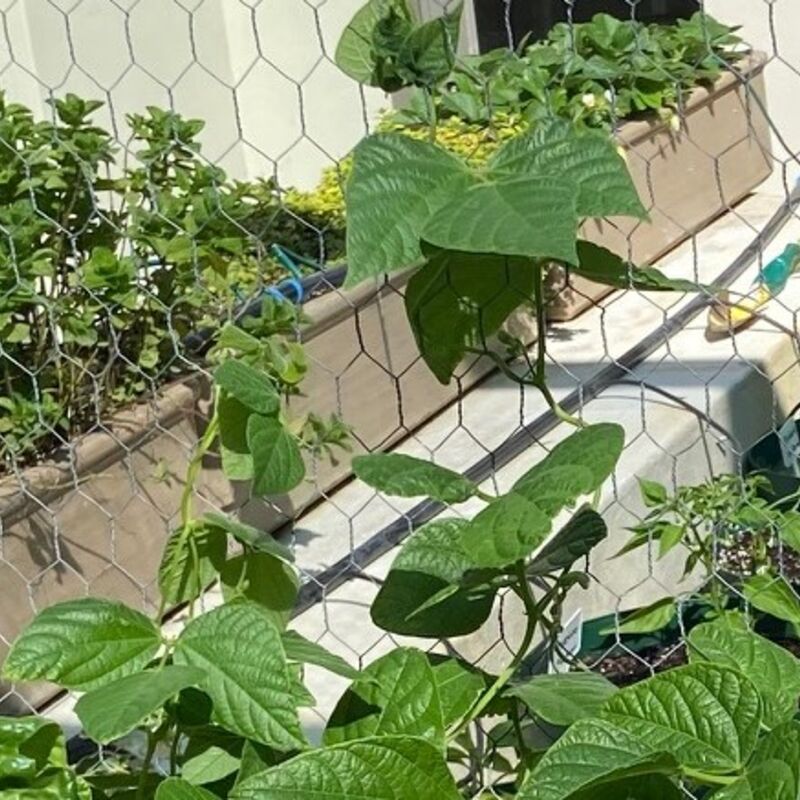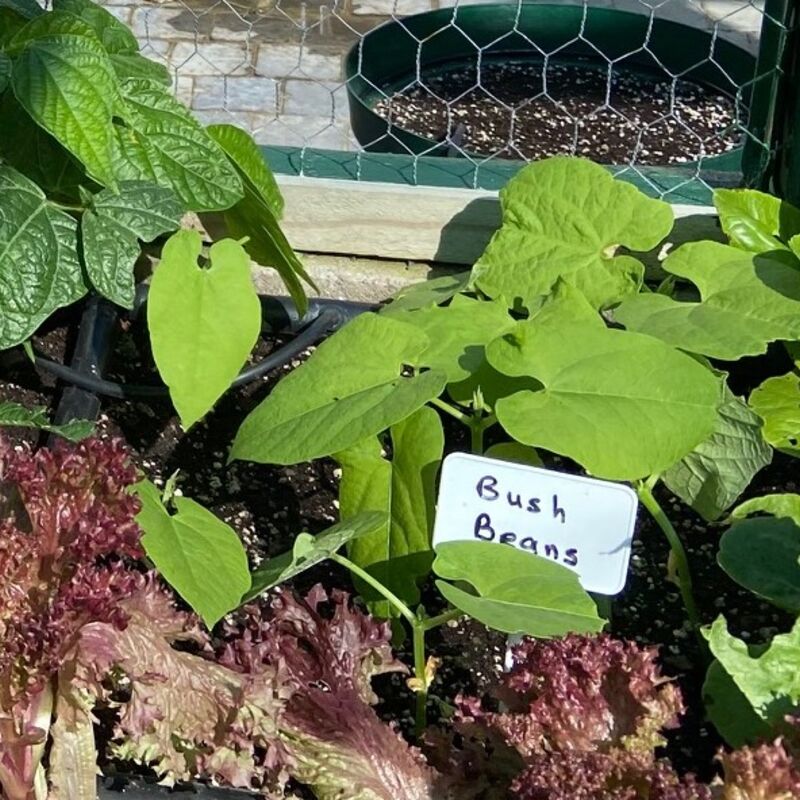Beans
Over 130 varieties (cultivars) of edible pod beans are known.
Varieties specialized for use as green beans, selected for the juiciness and flavour of their green pods, are usually grown in the home vegetable garden, and many varieties exist.
Beans with various pod colours (green, purple, red, or striped) are collectively known as snap beans, while green beans are exclusively green.

Runner beans in bed D in WW month 4 climbing up the outer chickenwire mesh in 2021

Bush beans planted in bed D in WW 4 in 2021
Green Beans (Phaseolus vulgaris)
Although green beans are relatively easy to grow, they have some unique features, particularly growing requirements. harvesting, storage and culinary characteristics. For this reason, I have provided more detail than usual.
Green beans are the unripe, young fruit of various common bean cultivars and are known by many common names, including French beans, string beans, snap, beans, and snaps.
They are distinguished from the many other varieties of beans in that green beans are harvested and consumed with their enclosing pods before the bean seeds inside have fully matured.
History
The green bean (Phaseolus vulgaris) originated in Central and South America, and there's evidence that it has been cultivated in Mexico and Peru for thousands of years.
Appearance
Green beans are classified by growth habit into two major groups, "bush" (or "dwarf") beans and "pole" (or "climbing") beans.
The bushes of bush beans spread out along the ground and only grow to about 1–2 feet (0.30–0.61 m) high. While bush beans only produce a single harvest during a growing season, they are relatively easy to grow and don't require much tending.
Pole beans climb vertically
Culinary
Green beans are eaten around the world and are sold fresh, canned, and frozen. They can be eaten raw or steamed, boiled, stir-fried, or baked.
They are commonly cooked in other dishes such as soups, stews, and casseroles.
Green beans can also be pickled, much like cucumbers are.
Green beans are a significant source of flavonol glucuronide and antioxidants in humans.
Cultivation
Green beans are a moderately simple crop to grow in the summer and fall and provide healthy, tasty food for you and your family. They should be watered daily.
I started to focus on green beans in 2021 in bed D , and found that beans were challenging to sustain throughout the season, so I have provided more detail than usual.
Bush beans take less time to mature than pole beans do, but pole beans are often more visually impressive.
Pole beans mature quicker than bush beans, growing continuously throughout the season, producing a larger crop, .and they can be harvested sooner.
Install a trellis for your pole beans to climb, such as a cattle panel, wooden lattice, or similar garden trellis.
Recommended pole varieties for most regions include Fortex and Kentucky Wonder.
Growing green beans
Green beans require 6 to 8 hours of sunlight daily to grow appropriately and loamy soil. Check your soil by squeezing it in your hands. Clay soil stays in a ball, and sandy soil falls apart. Loamy soil will hold its shape initially yet break apart when touched.
For those who have not made and used organic soil, if working with clay-heavy soil, spread 2 inches (5.1 cm) of manure or compost over the soil and work it into the top 1 foot (30 cm) of soil using a shovel, garden fork, or rototiller. You could also mix sawdust or sand into the soil if it is especially heavy.
If working with sandy soil, spread the same amount of heavy manure or compost into the soil in the same manner, but skip the sawdust.
Fertilizer
Apply a 10-20-10 fertilizer to the soil before planting the seeds. Green beans do not require many nutrients, but a light fertilizer application can help your plants produce a better crop. Use a shovel or trowel to mix the fertilizer into the top 3–4 inches (7.6–10.2 cm) of soil.
Sowing seeds
The best soil temperature during the planting stage is 55 °F (13 °C). Ideally, the temperature should warm to 77 °F (25 °C) once the plants reach the emergence stage. The minimum soil temperature for green bean seeds is 48 °F (9 °C).
Set up a trellis for pole beans, but not for bush beans.
Plant each seed about (2.5–5.1 cm) deep and about 3–6 inches (7.6–15.2 cm) apart and covered lightly with loose soil.
Avoid soaking the seeds before planting or immediately after planting. When exposed to excessive moisture, green bean seeds tend to crack and break.
Apply mulch to the soil where beans are planted.
Standard wood chip mulch or straw works well with green beans. Mulch can prevent the soil from getting too cool or too warm, and it also helps the soil retain moisture.
Apply roughly 3–4 inches (7.6–10.2 cm) of mulch over the plants after the soil has started to warm up.
Succession planting
Continue sowing green bean seeds every two weeks for a crop that lasts all summer and into fall.
Excessively hot weather may cause the plants to drop their blossoms and pods prematurely. For this reason, I use a shade cloth to protect my plants.
Caring for green beans plants
Water bean plants daily in the morning and skip watering on cloudy or rainy days, providing about 1–1.5 inches (2.5–3.8 cm) of water weekly.
Since I cover my plants with shade cloth, I also water them in the middle of the afternoon but regularly monitor the amount of moisture in my soil. I try to keep the soil moist and give the plants extra water if you notice the soil beginning to dry out.
Apply balanced fertilizer sparingly. Green beans grow well with minimal nutrients, and applying too much fertilizer could cause an overabundance of foliage yet a small yield of actual green beans.
Green beans prefer soils with a pH between 6.0 and 6.5. If your soil is especially acidic or basic, you might need to apply fertilizers formulated to balance the pH of the soil.
Remove weeds as needed.
Weeds can choke out green beans, making it difficult to emerge from the surface and strangle them once they do. Remove weeds as soon as you spot them to ensure a good crop of green beans.
When removing weeds, do not dig too deep. Green beans have shallow roots, and digging too deep into the soil can cause damage to these roots.
Pests and diseases.
There are a few pests and diseases to which green beans commonly fall victim.
Treat the plants with organic insecticides and fungicides as needed to keep these problems under control. Neem oil and sulfur are usually adequate fungicides.
Green beans are especially attractive to aphids, mites, cutworms, Mexican bean beetles, and Japanese beetles and are especially weak against white mould and mosaic viruses.
Get rid of aphids and mites by hosing them off your leaves with a hard burst of water.
Harvesting and storage
Pick the green beans during an immature stage. The pods should be firm, and you should be able to snap them off the plant without tearing the stems.
Green beans are usually about the size of a small pencil when ready to harvest. Harvest usually takes place 50 to 60 days from planting and 15 to 18 days after the full-bloom stage.
If the beans are given more time to mature, the pods will become more stringy and develop a tough outer skin.
Note that the seeds inside should not be allowed to develop fully. The inner seeds will turn hard at a fully developed, mature stage, a reliable visual signal that the beans are ripe.
In general, the beans will be fully grown and ready to harvest between 45 and 75 days after they're planted.
If you harvest the beans before they've fully matured and become stringy, your bean plants may produce a second harvest.
Break and string the harvested beans.
Bring the harvested beans into your kitchen, and fill a large pot with water. Snap the tip off of each green bean, and remove the long string from the front side of the bean. Then, snap each bean into 2 or 3 separate pieces. Drop the broken beans into the pot of water to rinse the dirt off of them
If you prefer your green beans whole, you can skip the breaking step. It's still best to string the beans shortly after they are harvested, though.
Store the green beans in a refrigerator.
Keep harvested green beans in an airtight container and store them for about 4 to 7 days in your refrigerator.
Freeze, can, or pickle green beans for long-term storage. The beans can be kept in the freezer for 3–6 months.